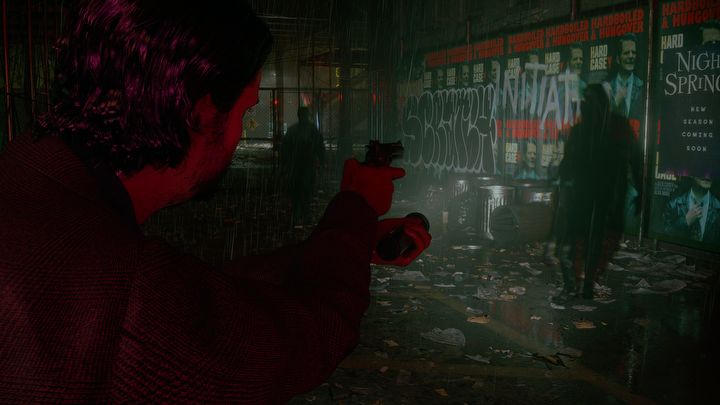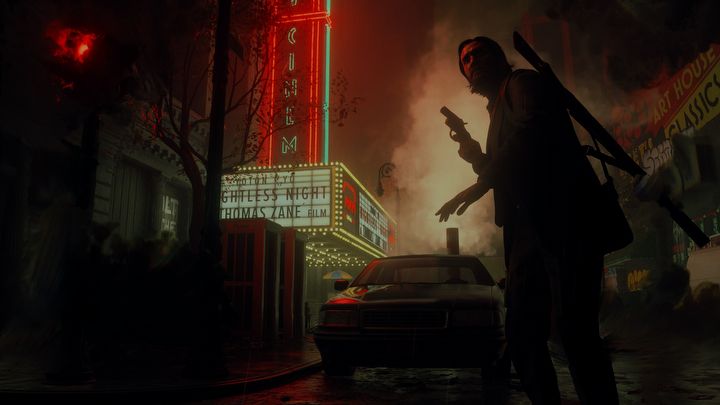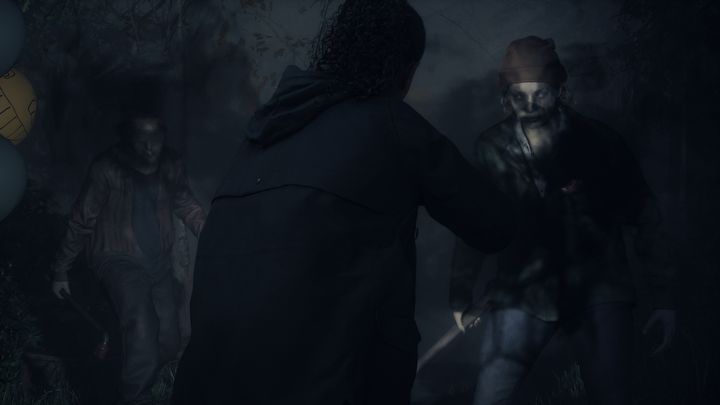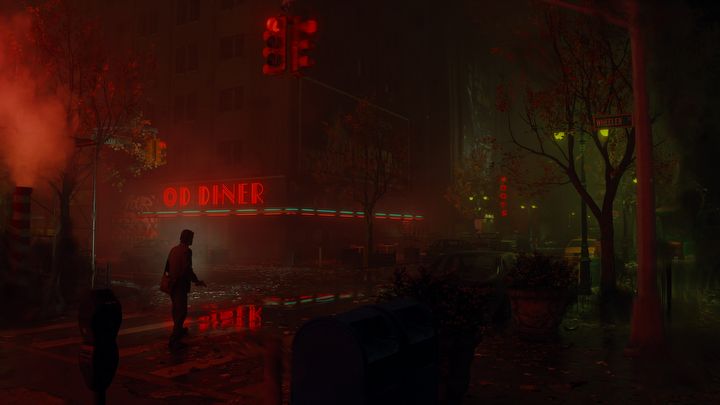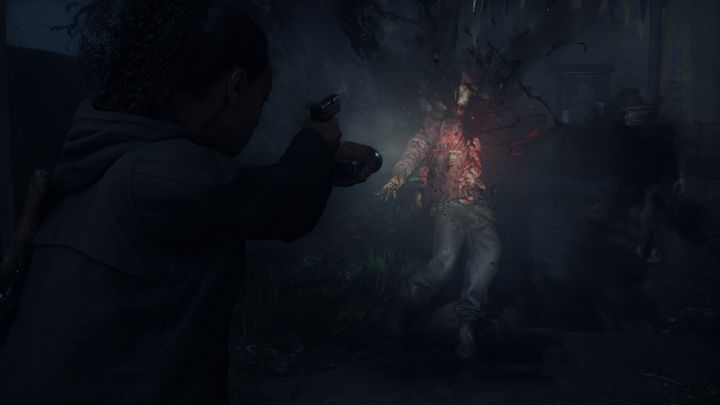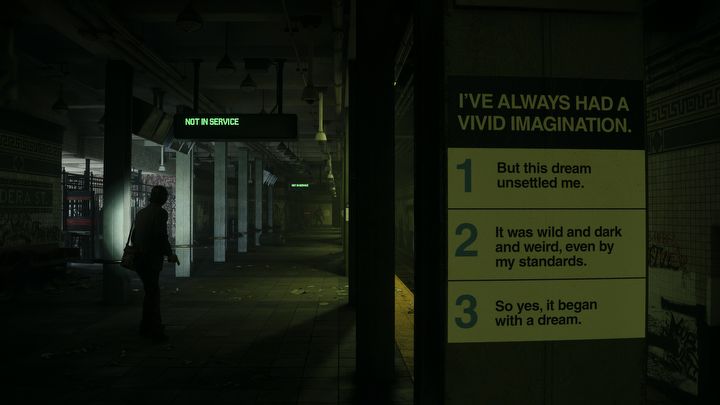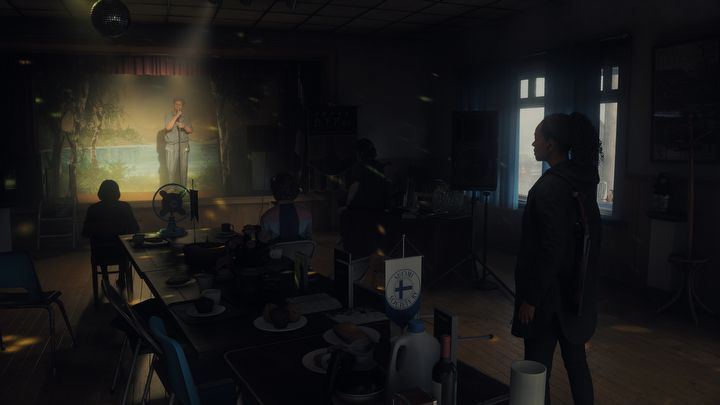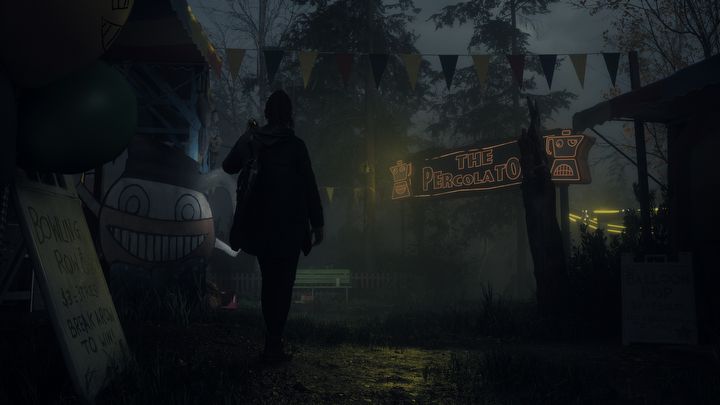Alan Wake 2: In-Depth Interview & Hands-On Impressions!
After thirteen years, the sequel to the original Alan Wake is set to release this October. We had the chance to try a hands-on demo and talk to the Game Director, Kyle Rowley, and have him answer a few questions regarding the upcoming hit.

Earlier this month I had the amazing opportunity to be among the first to get a hands-on demo of the upcoming Alan Wake 2. Recent trailers for the game have already been impressive, but getting the chance to play as both Alan and the new character, Saga, was an even more incredible experience. Not to mention the fact that I also sat down with the Game Director of Alan Wake 2, Kyle Rowley, to talk about the game:
Matt Buckley (Gamepressure.com): So over the last few weeks leading up to the event I've been playing the remastered version of the original Alan Wake. So I like that it’s fresh in my mind.
Kyle Rowley: Yeah, you’re in the headspace for it.
MB: Exactly. But one of the biggest differences I'm noticing is the shift from action-adventure to more like a slow-crawling horror. I was curious if there was kind of a decision point that went into why that change happened.
KR: Yeah, sure. When we were coming up with the concept of the game we obviously analyzed what we really liked about the first game: what things we thought we could do better. I think we did a really good job with the story, with the world, with the characters, and with the atmosphere. I think the gameplay was fun, and it was good. But there was a bit of a dissonance between the kind of story we're trying to tell with Alan Wake 2, which is a bit more of a slow-burn horror story, and the gameplay, which is very action-focused. We really wanted to bring the story and the gameplay closer together.
KR: So when we were thinking about what we were gonna do for the next game, we thought: “Okay, what if it was actually just a survival horror game?” Because this is a narrative-driven game, and Alan Wake as a franchise is very story-driven, we wanted to consider that aspect of the experience. Survival horror is much slower paced, we have more time to explore the world, and we can focus on the details of the world-building including exploring, finding nuggets of information, and discussions of characters. And then when we do get to the combat and we do get to the horror, it will feel much more impactful because you've been doing other stuff. So that was kind of like one of the starting points for how we kind of decided like, okay, I think this is the right direction to take the game.
Alan Wake 2 focuses heavily on the concept of environmental storytelling. A lot of time and energy was spent perfecting the incredible visuals of the Pacific Northwest through Saga’s gameplay, as well as the fictional New York City featured in Alan’s side of the game. These settings have a huge impact on the story, and they help compound the overall sense of dread through visual cues and aesthetics.
Unlike the original Alan Wake, the sequel does not have the player charging through narrative on a relatively linear path. Players are given the opportunity to really absorb the environment, meander, explore, find small details, and uncover clues. This gives the story and the player a moment to think, time to understand what is happening and what they need to do next.
When combat does eventually break out, the player has been anticipating it for a while. The tension has been building between strange details, conversations with suspicious NPCs, and the foreboding environment. Every aspect of the game has been funneling the player towards dread, and it delivers.
A story-first approach
MB: That leads me to the next question that I wanted to ask, which is what are the challenges you've come across in designing the story first as opposed to gameplay?
KR: Yeah, it's interesting, because I think that we are very focused on the characters. We generally knew the high level story that we wanted to tell. But it's not like it was set in stone. When we started the concept of this game, we had a high level idea of what it potentially could be. And then we knew that we wanted to introduce Saga as a character, we knew that she was going to be an FBI agent and profiler. Obviously, we knew that we had Alan in the game. So we wanted to create an interesting character arc for those characters, and make sure the story from both perspectives works and creates a cool overall story.
KR: We also wanted to make sure the player felt like they were filling the role of that character. So from a gameplay perspective, it was very interesting because we wanted to fill this fantasy of being an FBI agent and being a profiler. And that kind of instigated those discussions like, what does that mean for the player? How can they feel like they are filling that role? So that kind of led us into: “Okay. What if we have a case board?” Or, how do we fulfill this protected path fantasy, so that it's not like we are purely driving through from narrative moment to narrative moment.
KR: What the player does is also very important for us and that's why in Alan Wake 2 we have more game mechanics already than any game we've ever had before, because we just knew that we wanted to make sure the player felt like they were fulfilling the role that the story required them to fill.
MB: I've noticed that there are a lot more puzzles and a lot more figuring things out in this game.
KR: Yeah, exactly. I think that detective elements and horror worked very well together. It’s great because it's the type of horror that we want to do. We want to have this kind of slow burn, like things aren't quite right. There's a sense of dread and anticipation for something and the more we can get the player in the game exploring, the more we can layer that on until we get to the point where we want to reveal something. So again, it comes back to why we switched the genre to survival horror. I think it helps us with that sense of story. It's better for it, basically.
After the long thirteen-year hiatus, playing as the new character, FBI Agent Saga Anderson, is the perfect way to return to this series. Not only does the player learn or re-learn the story along with Saga, but coming at the story from a detective-like experience also helps to slowly build the tension as the entire picture comes into frame.
This called for a game mechanic in which the player could piece the story together, like a puzzle, hence, Saga’s Mind Place. If you really want to play the classic detective role, you can grab some red yarn and create webs of connected clues on the Case Board. The Mind Place and Case Board, along with various puzzles and riddles found throughout exploration, keep the detective fantasy alive in the player’s mind. Although, it is important to note that each clue has a predetermined location on the Case Board. This means that players can’t get completely lost, but it also means you can’t have fun creating your own chaotic web of conspiracies.
An important part of any horror experience is making sure the player or viewer has time between the action to collect themselves, to recover from the horror, only for the tension and suspense to begin building again. The Mind Place provides a necessary sanctuary.
Two protagonists
MB: So talking about both Alan and Saga. I know you can switch back and forth between the two. Are both stories completely optional? For example, can you play through just as Saga or just as Alan or is there any point where you have to switch?
KR: We wanted to create one story, one game. We start the game off by introducing Saga and introducing the setup. So she arrives at the Pacific Northwest: Bright Falls. There are these serial killings, and she's coming there with Alex Casey to investigate. And then after that we go to see Alan's side of the story, introducing the player to the dark place, its nightmare New York, what's he been doing, and we introduce his mechanics. After that point, you as a player can decide which character and which part of the game you want to play through.
Basically we don't force anything. So you can play all the way to the end of each character's arc, and then once you get to the end, you do have to go back and play the other character's. Then you can finish the game off. So there is a set path at the start and at the end, but everything in between is really up to you. And it's been written that way. If we were going to write and make a game where we forced you to switch into characters throughout the journey, we would have written a different story than the one that we've done here. The story's been written specifically with the understanding that you can switch characters in mind.
Saga’s investigation feels a bit more like the original Alan Wake. She trudges through the rainy, foggy forests around Bright Falls, fighting off the Taken, and slowly figuring out what the hell is going on. Then, Alan’s gameplay, exploring a chaotic stylized New York City, takes a slightly different tone. Alan already has far more understanding of the Dark Place and its powers. Now he is just trying to escape it. There are still elements of investigation as Alan works his way through the supernatural, but at this point, Alan is much more accustomed to the supernatural.
One side of the story may appeal to you more than another, perhaps Saga’s investigation is more enjoyable than Alan’s struggle with the Dark Place, but both are equally important to the overall story. Some amount of trust will have to be given to the developers that both sides of the story are worth playing. It’s just a matter of what order the player wants to tackle them.
Also, the fact that the game was specifically written with freedom of choice in mind gives some confidence that there really isn’t a “right” way to take on this game. Whether the player wants to swap back and forth every other mission, or play one character all the way through first, it seems like the narrative won’t suffer for it.
Open world vs hubs
MB: I know the term “open world” gets thrown around a lot, and it's kind of hard to tell just based on what I've been playing, but it does seem like there's a lot more freedom to wander about and focus on different things in the environment than in the first game.
KR: Yeah, that was a design philosophy that we definitely wanted to take. I think that Control was the first game where we introduced this kind of slightly more Metroidvania, free-to-go-where-you-want philosophy. We wanted to maintain that because I think that's just a more modern way of playing games. Giving the player the agency to decide where they want to go and how they want to get there. So we have the three hubs in the Pacific Northwest including Watery, Cauldron Lake, and Bright Falls. When you arrive at any of them you can freely explore and backtrack as far as you want. We didn't want to lock off exploration content at all. So no matter where you are in the story you can go back and do some of the side content if you want to. It's definitely a more freeform experience.
MB: I was also curious if there were any important decisions within that. For example, if you want to investigate a certain area, will that have an impact on what happens next? Or maybe like different endings to the story or anything like that?
KR: We had the one story we definitely wanted to tell. We wanted to give the player that freedom to decide how they want to consume that story as they want. There's no choice and consequence or anything like that. Mainly we wanted to allow the players to consume it at their own pace at their own leisure. That's what our design philosophy was. Just because we knew the story we wanted to tell and we didn't want to dilute it.
So while there will be a lot more freedom in how the player approaches the gameplay, Alan Wake 2 will not be fully open-world. It will have several hubs, much like Remedy’s previous game Control. For a narrative driven game, this is definitely a good thing. The team had one story that they wanted to tell, and the player does have a lot of freedom to explore that story in their own way, but at the end of the day, it’s still about the one story.
Also, because there is such a focus on the story, that does mean that player decisions won’t leave much of an impact. Of course, there will be small details or certain NPCs that might be missed if the player doesn’t catch them, but that’s probably it. This might not be the most replayable game, which makes sense given its focus on story.
For a narrative-driven game, the Remedy team seems to be making all the right choices. An open world environment would distract from the main narrative, and different options could also complicate things. The developers really held onto the idea of telling one story, and so far it seems to be working.
Favorite mechanic
MB: Do you have any favorite mechanics or anything that you're excited to get into the game?
KR: Yeah, I think all of the Mind Place/Case Board stuff, the Writer’s Room, rewriting reality. I think that those are mechanics that are very unique to this experience that you will not get anywhere else basically. A lot of work went into trying to figure that out and trying to make sure that the two characters didn’t feel like completely different games. Because it's one game, we didn't want to create two games. We wanted to make sure the players didn’t have to relearn everything when they switch between Alan and Saga. So trying to make sure the controls were the same and the core concepts were there, but they had their own twist. And I think that was something that we really wanted to try and achieve. I think that I'm quite pleased with the way that that came out.
When comparing the two storylines side by side, it is easy to mistake them for separate games. They are fairly different: separate protagonists, vastly different settings, and even different ways of interacting with that setting. But once you start playing, the similarities become more apparent.
Saga’s Mind Place is important for understanding and connecting important clues. She can use profiling to recognize what certain NPCs are thinking or doing and know how best to react. Meanwhile, Alan’s analogy to the Mind Place is the Writer’s Room. From here Alan can put together the story, and since his writing has an effect on the Dark Place, he can effectively rewrite reality, changing obstacles in his path to suit his needs.
It is surprising just how familiar the mechanics can feel, even when the Mind Place and the Writer’s Room can seem so different at first glance.
A sense of scale
MB: I have to ask, will driving come back?
KR: We do not have plans for that. At least not on the player’s side. When you're moving between locations, you can use Saga's car. And then we have sequences where we show her driving, and sometimes there's narrative stuff that plays over the top. But we wanted to aim to have no loading screens in the game, basically unless you died or something like that.
KR: One of the good things about Alan Wake 1, because originally it was an open world game, is that the sense of place was there, the sense of scale. And we really wanted to try and keep that. So that even though we are doing smaller, hub based locations when you're moving between them, we wanted to show some of the scale of the Pacific Northwest. So yeah, we still get that sense of scale. That was something that was important to us.
I’m glad my ridiculous question actually led to something interesting here. Despite the game not being open-world, exploring the town and surrounding area of Watery with Saga didn’t feel boxed in at all. Compared to the original game, this mission felt far more free-form. The player has a few objectives that will lead to certain areas and plot points, but it never felt like I couldn’t take my time to explore, or that there was only one way to approach a goal.
The idea of having no loading screens is also a great touch to make the world more seamless. The game lives up to the promise, and the only times loading screens came up in either mission was when Saga or Alan met an unfortunate early end. There’s still a lot more game to experience, but so far it seems the game has generally accomplished the goal of a fully immersed experience.
Incorporating live action
MB: So, the Night Springs episodes. Will there be anything like that? Live action TV episodes or web series?
KR: Live action is a key part of the experience. For example, in Saga's experience, we do have TV adverts and interesting live action material that you can discover and find. That stuff is meant to be building out certain characters or building up the world. We've got radios again, like we had in the first game. We have a lot of that extra additional side content that you can find just by exploring the game if you want to.
If you’ve seen some of the trailers, you may have noticed the integration of live action moments into the game. When Saga is profiling, the person or people in question will appear over her shoulder as live action actors. But there is a lot more to this.
During the section of gameplay as Alan, there was an actual cut scene that was fully live action. So while long-time fans may not have a series like the Night Springs episodes to look forward to, the game itself might actually scratch that itch.
The Remedy-verse
MB: It was revealed earlier today during the Q&A that the Federal Bureau of Control will be appearing in this game. Are there going to be any more connections to the larger “Remedy-verse”?
KR: When we're building the games, we start with the main game. We're trying to make the game story that we have for Alan Wake 2 the best it can be. And then once you've kind of got that solid foundation, we are obviously very excited about finding ways to connect them to other experiences and fleshing out that world. And even inside the team, because obviously, we are working on Control 2, and while that team isn't necessarily completely up to date with what we’re doing on Alan Wake 2, they will see stuff and be like "oh we should definitely connect some stuff to that." So you know, I think internally inside Remedy there is an appetite to build that world out. But for us as a studio, and on the project with this game, we really want to make this game great, and then we try and layer in some of that stuff. And for sure, there is quite a lot to discover in this game. We like hiding things in plain sight. We like having mysteries, we like having small nuggets and easter eggs. That's just our thing as a studio and that's what we do. I think we love seeing people trying to figure it all out on Reddit, or wherever.
MB: That is definitely true. After playing the Saga section someone sitting next to me was telling me "I think I saw a hint of Silent Hill because I saw a coat hanging on a tree." And I was like, "Oh, I wonder.” So I feel like there's gonna be a lot of that speculation. It's great that all the connections come naturally.
There is no doubt that Remedy likes to insert fun references and connections into their games. There are several references to the other Remedy games like the Max Payne series in the original Alan Wake. Even in the short demo mission from Alan’s perspective, he needs to infiltrate the Oceanview Hotel. Fans of Remedy’s Control will recognize it as a reference to the Oceanview Motel from that game.
Pop culture has been having fun with a lot of connected media universes, the Marvel movies being the biggest example. It’s no surprise that anyone could get tired of this concept, but thankfully, it doesn’t seem like the team behind Alan Wake 2 is sacrificing the quality of their own game for cheap connections to others.
The teams at Remedy are no doubt collaborative to some degree, and Control 2 might end up having more connections to the Alan Wake series than the original Control, but it would be surprising to see it take a large role in the narrative. That also goes for Alan Wake 2, even though the Bureau of Control does make an appearance.
Influence & inspiration
MB: Since it's been such a long time since the first game, I was curious if there have been any changes in influence? Maybe games that have come out or shows that have come out since then?
KR: For sure. I think that Resident Evil 2 Remake came out at just the right time for us. It kind of reignited the passion of horror games in a way. How you can modernize them and still make them play very well. So I think that was great. My favorite horror games in the past were Silent Hill, actually. I'm much more on the atmospheric and psychological. That sense of dread and the buildup of the horror rather than just continuous jumpscares and stuff like that. So on the game side that's more where I'm interested. Gameplay-wise and bringing the camera closer, the slower pace, I think it was good for us that Resident Evil 2 came out at the right time. Yeah, it happened to be a coincidence.
MB: It shows. I've been playing the remaster a lot the last few weeks and today has been a bit of a shock. In the original game, most of the enemies go down after two shots with a pistol. But in this game the enemies are a little bit harder to take down.
KR: Yeah. Because we have less of them, we wanted to make them feel more intimidating. One of the things that we focused on was like well first of all: survive with light. So this idea that you have to use light as a key part of things. We wanted to make sure that light versus darkness was represented. But the other thing is making it feel desperate, bringing enemies up close and personal, grabbing you so you have to try and escape, and then throwing you, destroying the environment, and all that. So trying to kind of layer in those elements to make it feel frantic. That with the resource management on top, so that's kind of important for us.
Frantic was definitely an emotion I felt playing Alan Wake 2. Desperate is another one that comes to mind. I blame a few mechanical changes for that feeling. First of all, the flashlight is much easier to expend as a resource now. It does not recharge if you don’t use the full battery. Instead, the flashlight has charges, and using it depletes a charge. This is important because as anyone who’s played the original Alan Wake knows, enemies are invulnerable unless your flashlight breaks their darkness shield first.
On top of that, a well-aimed shot with the crossbow or shotgun might take one enemy down, but smaller weapons, like the pistol, require more valuable bullets. Finally, health does not regenerate over time when near a light source. Players must instead find pain meds and bandages to replenish their health throughout the gameplay. Managing resources like this while desperately fighting off threatening enemies takes a toll.
This combat style, where each individual enemy is a serious threat, is a lot more reminiscent of games like Resident Evil and Silent Hill, showing how successfully this sequel has managed to shift genres. Limiting resources is a great way to organically up the stakes and quickly rack up tension. Should I use my flashlight now, or save it for later when there might be tougher enemies? Making snap decisions while a Taken is swinging their axe might not always end up being the right decision down the line. These decisions can snowball to nightmarish effect.
Conclusion
That is all the time I had with Alan Wake 2 Game Director Kyle Rowley. The last question I wanted to ask was why I have to wait until October to play more of this game. Alan Wake 2 is a game that takes a lot of care in the small details. Some of my favorites include the moths swarming around the lights at safe havens. It makes the wider world feel more real, and I began to feel a strange kinship with the moths.
I also wrote down in my notes that “doors become adversaries” in this game. I think what inspired me to write that down was how this game challenges you with much more than just shadowy figures with axes. In her mission, Saga has to break through a locked door by reading Coffeeworld employee notes to find where they left the screwdriver. Then, in Alan’s mission, the doorway to the Oceanview Hotel becomes an endless loop that has to be circumvented some other way.
There is a lot to explore in Alan Wake 2, and thankfully it gives you the time to do just that. Although honestly, I could have used a lot more time than the few hours I was given to search for all the incredible details the team at Remedy managed to include. For now, I will try to be patient.
Alan Wake 2 launches for PS5, Xbox Series S and X, and PC via the Epic Games Store on October 27th. Thanks to Remedy Entertainment and Epic Games for the opportunity to get a first look at this long-awaited game, and thanks again to Kyle Rowley for the great conversation.
